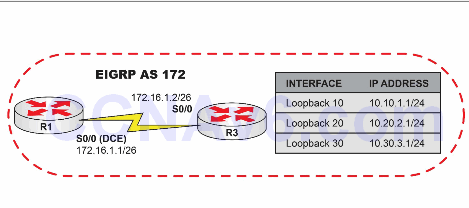Lab Objective:
The objective of this lab exercise is for you to learn and understand how to verify the EIGRP database using the appropriate Cisco IOS commands.
Lab Purpose:
Verifying the EIGRP database is a fundamental skill. EIGRP is an advanced distance vector protocol that incorporates features from both distance vector and link-state routing protocols. The EIGRP database is a feature of link-state routing protocols. As a Cisco engineer, as well as in the Cisco CCNA exam, you will be expected to know how to verify routes in the EIGRP database.
Certification Level:
This lab is suitable for CCNA certification exam preparation.
Lab Difficulty:
This lab has a difficulty rating of 6/10.
Readiness Assessment:
When you are ready for your certification exam, you should complete this lab in no more than 10 minutes.
Lab Topology:
Please use the following topology to complete this lab exercise:

Task 1:
Configure hostnames on R1 and R3 as illustrated in the topology. Since R1 S0/0 is the DCE end of the back-to-back Serial connection, configure R1 to send R3 clocking information at a rate of 256 Kbps. Configure the IP addresses for R1 and R3 S0/0 interfaces as specified in the topology and ping between the routers to verify connectivity based on your configuration.
Task 2:
Configure the Loopback interfaces on R3 as illustrated in the topology.
Task 3:
Enable EIGRP using ASN 172 on both R1 and R3 and configure EIGRP network statements for R1 and R3 S0/0 interfaces and for the Loopback interfaces on R3. Ensure that EIGRP does not perform automatic summarization at classful network boundaries.
Task 4:
On R1, verify the state of the received routes in the EIGRP database using the appropriate show commands. To take a more detailed look, also verify the EIGRP database information of the 10.20.20.0/24 subnet.
Configuration and Verification
Task 1:
For reference information on configuring hostnames, please refer to earlier labs.
Task 2:
For reference information on configuring Loopback interfaces, please refer to earlier labs.
Task 3:
For reference information on enabling EIGRP, please refer to earlier labs.
Task 4:
R1#show ip route eigrp
10.0.0.0/24 is subnetted, 3 subnets
D 10.30.30.0 [90/2297856] via 172.16.1.2, 00:00:33, Serial0/0
D 10.20.20.0 [90/2297856] via 172.16.1.2, 00:00:34, Serial0/0
D 10.10.10.0 [90/2297856] via 172.16.1.2, 00:00:34, Serial0/0
R1#ping 10.10.1.1
Type escape sequence to abort.
Sending 5, 100-byte ICMP Echos to 10.10.10.1, timeout is 2 seconds:
!!!!!
Success rate is 100 percent (5/5), round-trip min/avg/max = 4/6/8 ms
R1#ping 10.20.2.1
Type escape sequence to abort.
Sending 5, 100-byte ICMP Echos to 10.20.20.1, timeout is 2 seconds:
!!!!!
Success rate is 100 percent (5/5), round-trip min/avg/max = 4/6/8 ms
R1#ping 10.30.3.1
Type escape sequence to abort.
Sending 5, 100-byte ICMP Echos to 10.30.30.1, timeout is 2 seconds:
!!!!!
Success rate is 100 percent (5/5), round-trip min/avg/max = 4/6/8 ms
R1#show ip eigrp topology
IP-EIGRP Topology Table for AS(172)/ID(17.16.1.1)
Codes: P - Passive, A - Active, U - Update, Q - Query, R - Reply,
r - reply Status, s - sia Status
P 10.30.30.0/24, 1 successors, FD is 2297856
via 172.16.1.2 (2297856/128256), Serial0/0
P 10.20.20.0/24, 1 successors, FD is 2297856
via 172.16.1.2 (2297856/128256), Serial0/0
P 10.10.10.0/24, 1 successors, FD is 2297856
via 172.16.1.2 (2297856/128256), Serial0/0
P 172.16.1.0/26, 1 successors, FD is 2169856
via Connected, Serial0/0
NOTE: The output of the show ip eigrp topology command will show you the EIGRP router ID of the local router, the route metric, Feasible Distance, Successors, and Feasible Successors (if applicable). These are core EIGRP components that you are expected to know. Take some time to familiarize yourself with the information contained in the output of this command. It should be explained in more detail in your theory guide.
R1#show ip eigrp topology 10.20.2.0 255.255.255.0 IP-EIGRP (AS 172): Topology entry for 10.20.2.0/24 State is Passive, Query origin flag is 1, 1 Successor(s), FD is 2297856 Routing Descriptor Blocks: 172.16.1.2 (Serial0/0), from 172.16.1.2, Send flag is 0x0 Composite metric is (2297856/128256), Route is Internal Vector metric: Minimum bandwidth is 1544 Kbit Total delay is 25000 microseconds Reliability is 255/255 Load is 1/255 Minimum MTU is 1500 Hop count is 1
NOTE: The output of the show ip eigrp topology [network] [mask] command will show you where the route is from, the composite metric of the route, and the components included in the calculation of the metric, such as bandwidth, delay, reliability, load, and MTU. It also includes the hop count of the route. Again, these are core EIGRP components that you are expected to know. Therefore, take some time to familiarize yourself with the information contained in the output of this command.
